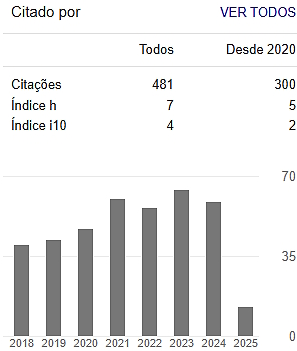PortuGamesVR: The Teaching of Portuguese in the Brazilian State Elementary Schools Assisted by Virtual Reality
Keywords:
Education, Virtual Reality, Portuguese language teachingAbstract
With the evolution of information technologies, their use in school education has been discussed, but few projects were actually implemented, as they are difficult to implement and understand for both the student and the teacher. They are widespread among new generations and the trend is to increase, since their use is directly related to the daily lives of students. However, the student environment still uses traditional teaching methods, which are not consistent with the student's reality, generating conflicts that can hinder learning. Therefore, this work presents a virtual reality tool that provides interactive three-dimensional virtual environments in order to assist the teaching/learning of Brazilian elementary school students in the discipline of Portuguese language. The virtual environments were evaluated by the project researchers through a specific usability questionnaire for this type of environment, obtaining a final average of 4.93 out of 5.0, being considered suitable for future use in classrooms.
Downloads
References
AMARAL, Elisabeth Cristina Ecker. A TIC - Tecnologia da Informação e comunicação na educação. Revista Belas Artes, Ano 7, n.19, 32p., 2015; Disponível em: <https://www.belasartes.br/revistabelasartes/downloads/artigos/7/a-tic-tecnologia-da-informacao-e-comunicacao-na-educacao.pdf>. Acesso em: 15 ago. 2019
BRAGA, M. Realidade virtual e educação. 2001. 6 f. Disponível em: <http://joaootavio.com.br/bioterra/workspace/uploads/artigos/realidadevirtual-5155c805d3801.pdf>. Acesso em: 17 ago. 2019
BROOKE, J.; SUS: A “quick and dirty” usability scale. Usability Eval. Ind. 189., 1995. Disponível em: <https://www.researchgate.net/publication/228593520_SUS_A_quick_and_dirty_usability_scale>. Acesso em: 06 dez. 2021
CURRÍCULOPAULISTA; Currículo Paulista. São Paulo: Seduc SP, 2019. Disponível em: <https://efape.educacao.sp.gov.br/curriculopaulista/wp-content/uploads/2019/09/curriculo-paulista-26-07.pdf>. Acesso em: 15 set. 2020.
DINIS, F. M.; GUIMARÃES, A.S.; CARVALHO, B.R. AND MARTINS, J.P.; "Virtual and augmented reality game-based applications to civil engineering education," 2017 IEEE Global Engineering Education Conference (EDUCON), 2017, pp. 1683-1688, doi: 10.1109/EDUCON.2017.7943075.
FORTE, C.E. AND KIRNER, C. Usando realidade aumentada no desenvolvimento de ferramentas para aprendizagem de física e matemática. In: 6º Workshop de Realidade Virtual e Aumentada - WRVA 2009, Santos - SP. Anais do 6º Workshop de Realidade Virtual e Aumentada. Santos - SP: Unisanta. v. 1. p. 1-6.
FRADE, B. V.; GONDIM, P. H. C. C. AND SOUSA, P. M.; "The Use of Virtual Reality as the Object of Mathematics Learning," 2015 XVII Symposium on Virtual and Augmented Reality, 2015, pp. 137-141, doi: 10.1109/SVR.2015.27.
KAMIŃSKA, D; SAPIŃSKI, T.; AITKEN, N.; DELLA ROCCA, A.; BARAŃSKA, M. AND WIETSMA, R., "Virtual reality as a tool in mechatronics education," 2017 18th International Symposium on Electromagnetic Fields in Mechatronics, Electrical and Electronic Engineering (ISEF) Book of Abstracts, 2017, pp. 1-2, doi: 10.1109/ISEF.2017.8090721.
KITCHENHAM B., BRERETON OP., BUDGEN D., TURNER M., BAILEY J., LINKMAN S.; Systematic literature reviews in software engineering - a systematic literature review. Inf. Softw. Technol., Butterworth-Heinemann, Newton, MA, USA, v. 51, n. 1, p. 7–15, jan. 2009. ISSN 0950-5849. Disponível em: <http://dx.doi.org/10.1016/j.infsof.2008.09.009>. Acesso em: 02 mar. 2021. DOI: 10.1016/j.infsof.2008.09.009.
LDB. Lei de Diretrizes e Bases da Educação Nacional. LEI Nº 9.394, DE 20 DE DEZEMBRO DE 1996; Disponível em: <http://www.planalto.gov.br/ccivil_03/LEIS/L9394.htm>; Acesso em: 30 ago. 2019.
LIKERT, R.; A Technique for the Measurement of Attitudes, no. No 136-165 in A Technique for the Measurement of Attitudes, publisher not identified, 1932. Disponível em https://books.google.com.br/books?id=9rotAAAAYAAJ; Acessado em Novembro de 2020.
MARTINS, V.F.; GUIMARÃES, M.P. Desafios para o uso de realidade virtual e aumentada de maneira efetiva no ensino. 10 f. Dissertação (Mestrado) - Universidade Presbiteriana Mackenzie, São Paulo, 2002. Disponível em: <https://br-ie.org/pub/index.php/desafie/article/view/2780/2433>. Acesso em: 8 set. 2019.
PEREIRA, A.R. e PERUZZA, A.P.P.M. Tecnologia de realidade virtual aplicada à educação PréEscolar. 2002. 7 f. Disponível em: <http://br-ie.org/pub/index.php/sbie/article/viewFile/200/186>. Acesso em: 14 set. 2019.
PISA; Instituto Nacional de Estudos e Pesquisas Educacionais Anísio Teixeira. Brasil no Pisa 2018 (Programme for International Student Assessment) [recurso eletrônico]. –Brasília: Instituto Nacional de Estudos e Pesquisas Educacionais Anísio Teixeira, 2020. 185 p. : il. ISBN 978-65-5801-039-5. Disponível em: <https://download.inep.gov.br/publicacoes/institucionais/avaliacoes_e_exames_da_educacao_basica/relatorio_brasil_no_pisa_2018.pdf>; Acessado em Setembro de 2021.
RODELLO, I. A.; SAKAI, R. K.; MANOEL, E.F.; Um ambiente virtual para auxiliar o ensino de química em escolas de ensino fundamental. 2002. 8 f. TCC (Graduação) - Curso de Nao Sei, Fim, Marília, 2002. Disponível em: <http://rodello.fearp.usp.br/VRLabQuim/artigos/rodellowie2002.pdf>. Acesso em: 16 set. 2019.
RUSU, C., MUÑOZ, R., RONCAGLIOLO, S., RUDLOFF, S., RUSU, V., FIGUEROA, A.; Usability heuristics for virtual worlds. The Third International Conference on Advances in Future Internet (AFIN 2011), , n. c, p. 16–19, 2011.
SUTCLIFFE, A., GAULT, B.; Heuristic evaluation of virtual reality applications. Interacting with Computers, v. 16, n. 4, p. 831–849, 2004.
SUTCLIFFE, A. G., KAUR, K. D.; Evaluating the usability of virtual reality user interfaces, Behaviour & Information Technology, 19:6, 415-426, 2000; DOI: 10.1080/014492900750052679
UNESCO. Sustainable development begins with education: how education can contribute to the proposed post-2015 goals; 24p; Catalog Number 0000230508; 2014. Disponível em: <https://sdgs.un.org/sites/default/files/publications/2275sdbeginswitheducation.pdf>. Acessado em outubro de 2021.

